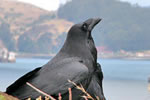Description |
The magnificent harpy eagle is one of the world's most powerful birds of prey, and the largest eagle found in the western hemisphere. Measuring up to 42 inches in length, and sporting a wingspan of close to seven feet, the harpy eagle can grow to a weight of up to 18 pounds. Females can be twice as large as males! This fearsome looking raptor has a grey head with an erect crest of long gray feathers and a massive, hooked bill. The back is covered with black or dark gray feathers. The underparts are white with some black barring on the feathers that lead to the feet. The claws may be the most impressive feature of the harpy eagle - they can reach a length of five inches and are larger than those of a grizzly bear. Despite their large claws, the harpy eagle can only carry away prey that is about of their body weight, nevertheless, this bird can pursue prey at speeds of up to 50 miles per hour and can see prey measuring only one inch in length at a distance of 200 yards. The harpy eagle is the national bird of Panama. |
| |
Diet |
| The carnivorous harpy eagle hunts in the rainforest canopy for medium-sized mammals such as sloths, monkeys, opossums, and birds. They may spend 23 hours a day silently perched waiting for prey to emerge. |
| |
Range/Habitat |
| The harpy eagle dwells in the canopies and emergent layers of dense tropical forests. Extremely local in range, harpy eagles may be found from the Yucatan Peninsula of Mexico, through the Atlantic coast of Central America, to the tropical forests of northern South America, south to northern Argentina. They are absent from much of Venezuela and large sections of Brazil. |
| |
Nesting |
| The nest of the harpy eagle can be up to 140 feet from the ground and are usually placed in the Great Kapok trees. The nest is so large that a fifth grader could easily sleep in it without bending his or her knees. Females lay one or two eggs, but if two eggs are laid, only one is incubated. Incubation may last for nearly two months. and eaglets are fed for up to ten months by the parents. |
| |
Status |
| The harpy eagle is a spectacular and rare bird that is extremely hard to observe in the wild because of their tendency to remain in the highest portions of the rainforest. It is considered a threatened species and has declined primarily because of intense deforestation, poaching, and nest robbing. These factors, combined with their low reproductive rates, are of major concern. In 1994, the San Diego Zoo became the first organization in North America to successfully breed the birds in captivity. |
| |
|














